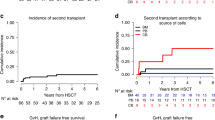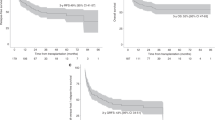Abstract
Hematopoietic stem cell transplantation (HSCT) is an established treatment for selected patients with inborn errors of metabolism. In this first report from the PDWP-SBTMO, we included 105 patients transplanted between 1988 and 2021 across six Brazilian HSCT centers. The most prevalent diseases were X-linked adrenoleukodystrophy (n = 61) and mucopolysaccharidosis (type I n = 20; type II n = 10), with a median age at HSCT of 8.7 years and 2.1 years, respectively. Most conditioning regimens were myeloablative and busulfan-based. With a median follow-up of 6.7 years, the 5-years overall survival (OS) was 75% (95% CI, 0.65–0.82) with a superior 5-years OS for those transplanted after 2010 (87% vs. 63%, p = 0.01). Higher risk of death was associated with the use of haploidentical donor (HR8.86, p 0.021), unrelated cord blood (HR 8.76, p 0.005), unrelated donor (HR 5.91, p 0.02), and for HSCT performed before 2010 (HR 4.16, p = 0.0015). The CI of acute GVHD was 24.8%, while chronic GVHD was 9.5%. Major causes of death were infections (n = 8), GVHD (n = 6), and neurologic progression (n = 3). Despite improvements in transplant outcomes since 2011, challenges persist, emphasizing the need for early diagnosis, timely transplantation and expanding HSCT centers with expertise in the field.
This is a preview of subscription content, access via your institution
Access options
Subscribe to this journal
Receive 12 print issues and online access
$259.00 per year
only $21.58 per issue
Buy this article
- Purchase on SpringerLink
- Instant access to full article PDF
Prices may be subject to local taxes which are calculated during checkout



Similar content being viewed by others
Data availability
The data supporting the findings of this study are available from the corresponding author (adrianamrpediatra@gmail.com) upon reasonable request.
References
Waters D, Adeloye D, Woolham D, Wastnedge E, Patel S, Rudan I. Global birth prevalence and mortality from inborn errors of metabolism: a systematic analysis of the evidence. J Glob Health. 2018;8:021102 https://doi.org/10.7189/jogh.08.021102.
Eapen M, Ahn KW, Orchard PJ, Cowan MJ, Davies SM, Fasth A, et al. Long-term survival and late deaths after hematopoietic cell transplantation for primary immunodeficiency diseases and inborn errors of metabolism. Biol Blood Marrow Transplant. 2012;18:1438–45. https://doi.org/10.1016/j.bbmt.2012.03.003.
Boelens JJ, van Hasselt PM. Neurodevelopmental outcome after hematopoietic cell transplantation in inborn errors of metabolism: current considerations and future perspectives. Neuropediatrics. 2016;47:285–92. https://doi.org/10.1055/s-0036-1584602.
Taylor M, Khan S, Stapleton M, Wang J, Chen J, Wynn R, et al. Hematopoietic stem cell transplantation for mucopolysaccharidoses: past, present, and future. Biol Blood Marrow Transplant. 2019;25:e226–e246. https://doi.org/10.1016/j.bbmt.2019.02.012.
Barth AL, de Magalhães TSPC, Reis ABR, de Oliveira ML, Scalco FB, Cavalcanti NC, et al. Early hematopoietic stem cell transplantation in a patient with severe mucopolysaccharidosis II: a 7 years follow-up. Mol Genet Metab Rep. 2017;12:62–68. https://doi.org/10.1016/j.ymgmr.2017.05.010.
Page KM, Stenger EO, Connelly JA, Shyr D, West T, Wood S, et al. Hematopoietic stem cell transplantation to treat leukodystrophies: clinical practice guidelines from the hunter’s hope leukodystrophy care network. Biol Blood Marrow Transplant. 2019;25:e363–e374. https://doi.org/10.1016/j.bbmt.2019.09.003.
Petryk A, Polgreen LE, Chahla S, Miller W, Orchard PJ. No evidence for the reversal of adrenal failure after hematopoietic cell transplantation in X-linked adrenoleukodystrophy. Bone Marrow Transplant. 2012;47:1377–8. https://doi.org/10.1038/bmt.2012.33.
Engelen M, van Ballegoij WJC, Mallack EJ, Haren KPV, Köhler W, Salsano E, et al. International recommendations for the diagnosis and management of patients with adrenoleukodystrophy: a consensus-based approach. Neurology. Published online September 29, 2022. https://doi.org/10.1212/WNL.0000000000201374.
Allewelt H, Taskindoust M, Troy J, Page K, Wood S, Parikh S, et al. Long-term functional outcomes after hematopoietic stem cell transplant for early infantile Krabbe disease. Biol Blood Marrow Transplant. 2018;24:2233–8. https://doi.org/10.1016/j.bbmt.2018.06.020.
Mallack EJ, Turk BR, Yan H, Price C, Demetres M, Moser AB, et al. MRI surveillance of boys with X‐linked adrenoleukodystrophy identified by newborn screening: meta‐analysis and consensus guidelines. J Inherit Metab Dis. 2021;44:728–39. https://doi.org/10.1002/jimd.12356.
Giugliani R, Federhen A, Michelin-Tirelli K, Riegel M, Burin M. Relative frequency and estimated minimal frequency of lysosomal storage diseases in Brazil: report from a reference laboratory. Genet Mol Biol. 2017;40:31–39. https://doi.org/10.1590/1678-4685-gmb-2016-0268.
Coelho JC, Wajner M, Burin MG, Vargas CR, Giugliani R. Selective screening of 10,000 high-risk Brazilian patients for the detection of inborn errors of metabolism. Eur J Pediatr. 1997;156:650–4. https://doi.org/10.1007/s004310050685.
Vieira TA, Trapp FB, Souza CFMD, Faccini LS, Jardim LB, Schwartz IVD, et al. Information and diagnosis networks—tools to improve diagnosis and treatment for patients with rare genetic diseases. Genet Mol Biol. 2019;42:155–64. https://doi.org/10.1590/1678-4685-gmb-2018-0214.
Wiens K, Berry SA, Choi H, Gaviglio A, Gupta A, Hietala A, et al. A report on state‐wide implementation of newborn screening for X‐linked adrenoleukodystrophy. Am J Med Genet A. Published online May 10, 2019. https://doi.org/10.1002/ajmg.a.61171.
Anderson S. Newborn screening for lysosomal storage disorders. J Pediatr Health Care. 2018;32:285–94. https://doi.org/10.1016/j.pedhc.2017.04.016.
Loes DJ, Fatemi A, Melhem ER, Gupte N, Bezman L, Moser HW, et al. Analysis of MRI patterns aids prediction of progression in X-linked adrenoleukodystrophy. Neurology. 2003;61:369–74. https://doi.org/10.1212/01.WNL.0000079050.91337.83.
Miller WP, Rothman SM, Nascene D, Kivisto T, DeFor TE, Ziegler RS, et al. Outcomes after allogeneic hematopoietic cell transplantation for childhood cerebral adrenoleukodystrophy: the largest single-institution cohort report. Blood. 2011;118:1971–8. https://doi.org/10.1182/blood-2011-01-329235.
Raymond GV, Aubourg P, Paker A, Escolar M, Fischer A, Blanche S, et al. Survival and functional outcomes in boys with cerebral adrenoleukodystrophy with and without hematopoietic stem cell transplantation. Biol Blood Marrow Transplant. 2019;25:538–48. https://doi.org/10.1016/j.bbmt.2018.09.036.
Kharfan-Dabaja MA, Kumar A, Ayala E, Aljurf M, Nishihori T, Marsh R, et al. Standardizing definitions of hematopoietic recovery, graft rejection, graft failure, poor graft function, and donor chimerism in allogeneic hematopoietic cell transplantation: a report on behalf of the American society for transplantation and cellular therapy. Transpl Cell Ther. 2021;27:642–9. https://doi.org/10.1016/j.jtct.2021.04.007.
Ball LM, Egeler RM, on behalf of the EBMT Paediatric Working Party. Acute GvHD: pathogenesis and classification. Bone Marrow Transplant. 2008;41:S58–S64. https://doi.org/10.1038/bmt.2008.56.
Schoemans HM, Lee SJ, Ferrara JL, Wolff D, Levine JE, Schultz KR.on behalf of the EBMT (European Society for Blood and Marrow Transplantation) Transplant Complications Working Party and the “EBMT–NIH (National Institutes of Health)−CIBMTR (Center for International Blood and Marrow Transplant Research) GvHD Task Force" et al. EBMT−NIH−CIBMTR task force position statement on standardized terminology & guidance for graft-versus-host disease assessment. Bone Marrow Transplant. 2018;53:1401–15. https://doi.org/10.1038/s41409-018-0204-7.
Jagasia MH, Greinix HT, Arora M, Williams KM, Wolff D, Cowen EW, et al. National Institutes of Health Consensus Development Project on criteria for clinical trials in chronic graft-versus-host disease: I. The 2014 diagnosis and staging working group report. Biol Blood Marrow Transplant. 2015;21:389–401.e1. https://doi.org/10.1016/j.bbmt.2014.12.001.
Kitko CL, Pidala J, Schoemans HM, Lawitschka A, Flowers ME, Cowen EW, et al. National Institutes of Health Consensus Development Project on criteria for clinical trials in chronic graft-versus-host disease: IIa. The 2020 clinical implementation and early diagnosis working group report. Transpl Cell Ther. 2021;27:545–57. https://doi.org/10.1016/j.jtct.2021.03.033.
Bartelink IH, van Reij EML, Gerhardt CE, Van Maarseveen EM, de Wildt A, Versluys B, et al. Fludarabine and exposure-targeted busulfan compares favorably with busulfan/cyclophosphamide-based regimens in pediatric hematopoietic cell transplantation: maintaining efficacy with less toxicity. Biol Blood Marrow Transplant. 2014;20:345–53. https://doi.org/10.1016/j.bbmt.2013.11.027.
Costa de Oliveira ML, Simoni RE, dos Santos CMRC, Fernandes MJ, Braga MJ, de Albuquerque RM, et al. A survey on inborn errors of metabolism in 323 neonates from the state of Rio de Janeiro, Brazil. Public Health Genom. 2002;5:257–61. https://doi.org/10.1159/000066686.
Rodrigues AM, Gomes A, Fernandes JF, Daudt L, Bonfim C. Brazilian consensus guidelines for hematopoietic stem cell transplantation—inborn errors of metabolism. J Bone Marrow Transplant Cell Ther. 2021;2:126.
Boelens JJ, Prasad VK, Tolar J, Wynn RF, Peters C. Current international perspectives on hematopoietic stem cell transplantation for inherited metabolic disorders. Pediatr Clin North Am. 2010;57:123–45. https://doi.org/10.1016/j.pcl.2009.11.004.
Nunes K, Aguiar VRC, Silva M, Sena AC, de Oliveira DCM, Dinardo CL, et al. How ancestry influences the chances of finding unrelated donors: an investigation in admixed Brazilians. Front Immunol. 2020;11:584950 https://doi.org/10.3389/fimmu.2020.584950.
Van Den Broek BTA, Page K, Paviglianiti A, Hol J, Allewelt H, Volt F, et al. Early and late outcomes after cord blood transplantation for pediatric patients with inherited leukodystrophies. Blood Adv. 2018;2:49–60. https://doi.org/10.1182/bloodadvances.2017010645.
Prasad VK, Kurtzberg J. Cord blood and bone marrow transplantation in inherited metabolic diseases: scientific basis, current status and future directions. Br J Haematol. 2010;148:356–72. https://doi.org/10.1111/j.1365-2141.2009.07974.x.
Brodsky RA, Luznik L, Bolaños-Meade J, Leffell MS, Jones RJ, Fuchs EJ. Reduced intensity HLA-haploidentical BMT with post transplantation cyclophosphamide in nonmalignant hematologic diseases. Bone Marrow Transplant. 2008;42:523–7. https://doi.org/10.1038/bmt.2008.203.
Vander Lugt MT, Chen X, Escolar ML, Carella BA, Barnum JL, Windreich RM, et al. Reduced-intensity single-unit unrelated cord blood transplant with optional immune boost for nonmalignant disorders. Blood Adv. 2020;4:3041–52. https://doi.org/10.1182/bloodadvances.2020001940.
Gupta A, Downey M, Shanley R, Jennissen C, Miller WP, Lund TC, et al. Reduced-toxicity (BuFlu) conditioning is better tolerated but has a higher second transplantation rate compared to myeloablative conditioning (BuCy) in children with inherited metabolic disorders. Biol Blood Marrow Transplant. 2020;26:486–92. https://doi.org/10.1016/j.bbmt.2019.11.014.
Lum SH, Miller WP, Jones S, Poulton K, Ogden W, Lee H, et al. Changes in the incidence, patterns and outcomes of graft failure following hematopoietic stem cell transplantation for Hurler syndrome. Bone Marrow Transplant. 2017;52:846–53. https://doi.org/10.1038/bmt.2017.5.
Fernandes JF, Bonfim C, Kerbauy FR, Rodrigues M, Esteves I, Silva NH, et al. Haploidentical bone marrow transplantation with post transplant cyclophosphamide for patients with X-linked adrenoleukodystrophy: a suitable choice in an urgent situation. Bone Marrow Transplant. 2018;53:392–9. https://doi.org/10.1038/s41409-017-0015-2.
Dias-Viana JL, Gomes GVA. Escala Wechsler de Inteligência para Crianças (WISC): análise da produção de artigos científicos brasileiros. Psicol Rev. 2019;28:9–36. https://doi.org/10.23925/2594-3871.2019v28i1p9-36.
Giugliani R, Taucher SC, Hafez S, Oliveira JB, Rico-Restrepo M, Rozenfeld P, et al. Opportunities and challenges for newborn screening and early diagnosis of rare diseases in Latin America. Front Genet. 2022;13:1053559 https://doi.org/10.3389/fgene.2022.1053559.
Kubaski F, Sousa I, Amorim T, Pereira D, Silva C, Chaves V, et al. Pilot study of newborn screening for six lysosomal diseases in Brazil. Mol Genet Metab. 2023;140:107654 https://doi.org/10.1016/j.ymgme.2023.107654.
Acknowledgements
The authors thank all the nurses, physicians, and multidisciplinary staff of the participating centers. The authors also thank all geneticists and neurologists that worked together with the transplant centers for the best treatment to each patient.
Author information
Authors and Affiliations
Contributions
AMR designed the study, enrolled patients, reviewed and analyzed data, and wrote the paper. JFF and LED designed the study, enrolled patients, and reviewed the paper. ACML performed the statistical analyses. CK and SN assisted with data collection, discussion, and manuscript review. GL and PP supported data collection, methodology, and discussion. JT, CAP, and JB contributed to data interpretation and manuscript review. RM contributed to data collection, statistical analysis, and result interpretation. LG, AK, and RTG reviewed manuscript. LMMG, FB, JLG, GZN, and AAG collected data. ABBM, FFS, and CGCJ contributed to data collection and reviewed the paper. NH and RP guided the study and reviewed the manuscript. CB offered guidance at all stages, coordinated data collection, and reviewed the manuscript. All authors discussed the results and commented on the manuscript.
Corresponding author
Ethics declarations
Competing interests
The authors declare no competing interests.
Ethics approval statement and consent to participate
The Brazilian Ethical Authority approved the study with identification number CAAE 44805321.5.0000.0097 (according to plataformabrasil.saude.gov.br). Written informed consent was obtained from all study subjects. This study has been performed in accordance with the Declaration of Helsinki.
Additional information
Publisher’s note Springer Nature remains neutral with regard to jurisdictional claims in published maps and institutional affiliations.
Rights and permissions
Springer Nature or its licensor (e.g. a society or other partner) holds exclusive rights to this article under a publishing agreement with the author(s) or other rightsholder(s); author self-archiving of the accepted manuscript version of this article is solely governed by the terms of such publishing agreement and applicable law.
About this article
Cite this article
Rodrigues, A.M., Fernandes, J.F., Gregianin, L. et al. Hematopoietic stem cell transplantation in inborn errors of metabolism—a retrospective analysis on behalf of the pediatric disease working party from the Brazilian Society of Bone Marrow Transplantation and Cellular Therapy. Bone Marrow Transplant 60, 474–481 (2025). https://doi.org/10.1038/s41409-025-02512-6
Received:
Revised:
Accepted:
Published:
Issue date:
DOI: https://doi.org/10.1038/s41409-025-02512-6



